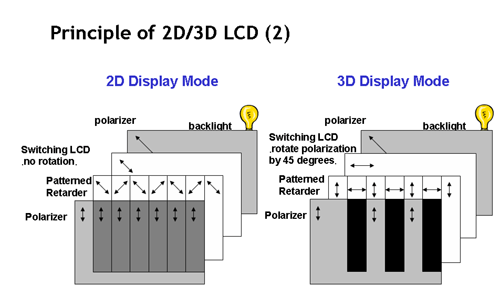COMDEX 2003 Display Coverage: Prelude to a CES
by Kristopher Kubicki on November 26, 2003 10:50 PM EST- Posted in
- Trade Shows
Sharp's 3D LCD
Fortunately, Sharp has a few images that can describe the technology better than we can. In a nutshell, instead of allowing the image to pass through the TFT substrate, a pattern retarder blocks alternating segments of light through the LCD. If you are sitting correctly, you will see one slightly angled image in your left eye, and a slightly different angled image in your right eye. The human brain perceives these two offset images as depth.Click to enlarge.
This is not a new concept. Using the red and blue glasses in 3D movie theaters accomplishes the same effect by filtering the red offset image via one eye and the blue offset image in the other eye. Of course, the revolutionary thing here is that we do not need goggles to achieve the same effect.
Click to enlarge.
Granted, this technology is not perfect yet. You do have to sit fairly still for the effect to work. Moving your head from left to right will result in a sort of wavy effect as you go from 3D to 2D and back to 3D. Also, since the retarding layer blocks alternate projections of the image, you actually are viewing only half of the screens capable brightness. On the other hand, this technology has a lot of promise. It is very easy to go from 2D to 3D and back, since the retarding layer can also be an LCD (power just needs to be applied over the LCD to turn it on and off). This also makes it relatively cost-effective. Furthermore, the technology is extremely capable. Even playing 2D developed games allow for an interesting degree of immersion; particularly, racing games tend to produce that 3D tunnel effect. We had the opportunity to demo a few games in the Sharp suite, and the small go-kart demo (which is natively a 2D game), produced an extremely captivating experience.
Video games will obviously be an enormous market for this emerging technology. Consider the fact that most games as we know it already exist in 3D. It is not very hard for a software driver to take two slightly different samples of UT2003 instead of one during game play, and then project both images one on top of each other to the signal output. Sharp is already working with NVIDIA and Microsoft for just that. Do not be surprised if we hear more about this technology at CES.
Sharp's next step for a technology like this would be to incorporate retina tracking capabilities in the monitor that could adjust the retarding layer to each person's eyes. As a bonus, this would allow you to move and view the 3D effect as well! Sanyo and Sony are also working on similar technology, but kudos to Sharp for being the first to bring a real world example to the world!












16 Comments
View All Comments
KristopherKubicki - Tuesday, December 2, 2003 - link
Sorry artifex, I updated it and forgot to mention it :)Kristopher
WooDaddy - Tuesday, December 2, 2003 - link
Kris,Cool. Look for a bunch of old guys in wife-beaters, drunk and with AVN passes around their necks touting the worlds-greatest new killer app.
My company's image is very important to me. As the founder, I'd have it no other way.
Woo
artifex - Tuesday, December 2, 2003 - link
oops, never mind, I see it's been changed to AGP and PCI, now.artifex - Tuesday, December 2, 2003 - link
I'm still hoping someone can tell me how they managed to have two AGP cards in a single system?KristopherKubicki - Monday, December 1, 2003 - link
Yes we will have a bit of CES coverage.Look for the young guys in suits :) Thats us!
Kristopher
WooDaddy - Monday, December 1, 2003 - link
Kris,I really hope that last comment you said about the CES is true. I'm planning on going this year. Do you or you collegues plan on going this coming year and doing an article?
Woo
KristopherKubicki - Monday, December 1, 2003 - link
most monitors are 8 bit, only the AUO 16ms panel is 6 bit. The LG Philips and Samsung 16 and 12ms panels are 8bit. Sharp is working on 10bit panels by the end of the year.Kristopher
ViRGE - Sunday, November 30, 2003 - link
Humm, I'm a bit depressed to see yet another monitor company leave the CRT space; I'm still not ready for LCDs financially, and I'm still iffy on their features considering the 6bit and pixel response times(I mean we're just now at 16ms, which is barely acceptable in my book since that's nessisary for 60fps). I hope NEC stays in the game a bit longer, otherwise I'm going to have to start hording CRTs(although the current Samsung 757MB I use will last for quite some time I'm sure).KristopherKubicki - Sunday, November 30, 2003 - link
LG Philips is doing first runs on its 19" 16ms S-IPS panel. I will have to try to check with NEC concerning that panel.I know NEC has had a lot of quantity issues. They dont have a huge production capability and they probably wont be able to persue it much longer.
Kristopher
miomao - Sunday, November 30, 2003 - link
Nec said they will use a proprietary S-IPS panel for the 1980SX successor. :\LG.Philips already make a 19'' 25ms S-IPS panel used in the LG L1910B model.
But the pro model L1910P has a Fujitsu MVA.
Someone say that maybe they still have production quantity problem (?)